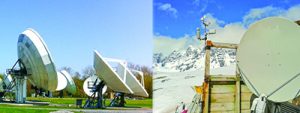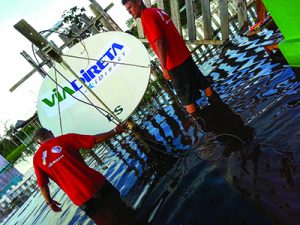
The rising demand from a constantly connected people means that comms on the move will be in higher demand than ever before. However, maintaining satellite communications whilst on the move is notoriously difficult. Maintaining signal whilst ensuring continuous links is as crucial as it is problematic, with even the slightest mispoint causing the signal to be out of range. Furthermore, if the equipment is not up to standard, then it won’t align properly, which whilst on the move can cause numerous complications. How can the satellite industry ensure that continual connection and minimise errors?
Demanding a Constant Connection
Comms on the move has always been crucial for a number of applications. For example, in the cruise industry it enables passengers to access their social media applications and OTT content, on any device. Satellite provides the best and unique communication method where no other communication network will reach. Hundreds of Mbs are being delivered per second in a reliable way to hundreds of cruises today. In a very similar manner, other maritime vessels are also connected, such as traditional shipping vessels and even yachts, a market that is currently booming.
The aero industry has for some time been another big user of comms on the move, both for commercial and cargo planes. Again, no other communication method could keep a plane connected throughout its journey. This has always been important, keeping the crew connected for important information, relating to weather and cockpit updates among other things. However, the constantly connected consumer is making it even more crucial for commercial aircraft to also supply a connection for customers.
 Consumers are used to always being online and rely on broadband connections for pretty much everything in their daily life. For a consumer on board a plane, whether that be an international or regional flight, whether that be a low cost or a flagship airline, today it has become a must have. There is an expectation that will continue on board, with very little consideration for the technical challenges of ensuring that.
Consumers are used to always being online and rely on broadband connections for pretty much everything in their daily life. For a consumer on board a plane, whether that be an international or regional flight, whether that be a low cost or a flagship airline, today it has become a must have. There is an expectation that will continue on board, with very little consideration for the technical challenges of ensuring that.
This demand is set to continue at a fast pace over the coming months and years and will extend beyond just those areas. For example, we will see an increasing appetite for connected cars will begin to emerge into the market. Of course, keeping a car connected presents all the same challenges of other comms on the move applications, with the added complication that a consumer will simply not want to, or know how to, troubleshoot any connection errors. Comms on the move will simply have to work, all the time, and be able to self-diagnose when there is a problem, without the need for any human intervention. Just imagine for a minute, that you bought the connected car of your dreams, and after couple of months you take it for a drive on a nice road, when a light on the dashboard shows it needs to go to the garage to repair and update the VSAT unit. Could you imagine the mechanic doing an update or troubleshooting the IDU or ODU or any IP? Most likely, this would be a disaster. Therefore, we need to take all measures to make it as robust as it could be, ensuring 99,99% availability and being able to maintain & test remotely.
 Challenges on the Move
Challenges on the Move
The technical challenges of ensuring constant communications on the move are not insignificant. The very nature of constantly moving makes maintaining a fix on the satellite challenging. It is all too easy to lose that alignment, or calibration, point to the wrong satellite, or lose the return link completely. Add to that the possibility of changing weather conditions and temperature on a journey, which can affect the satellite connection, and customer satisfaction.
At the same time, in the comms-on-the-move environment, the terminal has to be as small as possible. Nowadays, we are talking about few inches and cm, as the smaller the unit, the cheaper to manufacture, transport and deploy. With consumer applications such as connected cars, space will be even more limited. Meaning ever smaller terminals have to achieve what bigger terminals even have challenges with. Therefore, for our industry to survive, we need to ensure the very best performance from the smallest of terminals. We already have the situation in existing applications where the people tasked with looking after the satellite equipment are often not trained in satellite technology, imagine if the Tx beam is even wider. As we see consumer applications emerge, many people won’t even realise it is satellite technology, so we need to automate even faster and further for these markets.
So that we are one the move, let´s bring the moving satellites into play.
The Promise of LEO
Over the coming months and years, there are predicted to be a massive array of LEO and MEO constellations launching to tap into this demand for constant connectivity. I am a strong believer in the success of LEO constellations, which will find the much-needed investment and come to the market. With these constellations will come massive capacity, more than we will need in the foreseeable future. This means that capacity won’t be a problem, but it also means that there will be huge competition from LEO providers vying for customers. This year, there are 25 serious LEO constellations, so that competition will mean reduced costs on the capacity but it will also mean that those providers, more than ever, will need to ensure quality and consistency of service to retain the customer and that means they should be investing in the right technology to solve the LEO challenges in a seamless way to the customer.
These new constellations will come with their own set of challenges. One of the major concerns for the industry is the pure volume of constellations, which many fear will cause massive interferences with GEO. In our view, it does not need to be like that as long as we ensure the right tools are used. The other problem is that the nature of these means the process of connecting to the satellite is not as simple as in GEO where you lock onto the satellite and it doesn’t move (correlated to earth coordinates), but with LEO the movement of the satellites with respect of the earth makes this all the more complicated.
 How do we keep comms, on the move?
How do we keep comms, on the move?
Given the plethora of challenges, it is very easy to conclude that comms-on-the-move will become impossible to manage, but the truth is that tools just need to get better, and more clever, and this is done by innovating faster.
Firstly, knowing that antennas are not often operated by satellite engineers, there is a clear need for automation. The more automated the processes are, the less chance of error and the less knowledge needed by the user. There will, therefore, be a growing need for both automated tools to ensure initial alignment is accurate, as well as being quick and efficient, at the same time as using automated tools to ensure a connection is maintained even on the move with new satellites. This also means the systems need to be able to self-diagnose as much as possible, flagging up any errors and even potentially fixing them remotely.
Flat panel antennas will be absolutely critical to these new developments, especially for environments such as connected cars, where space will be at a premium. Eventually, these will need to be flexible enough to be used as plug and play, like smartphones are. The easier it is to operate, the better. Without these types of antennas, we can have neither the predicted growth of HTS nor new satellite constellations.
The other important factor is monitoring. This will become even more critical as we see the launch of numerous LEO and MEO constellations. Being able to constantly monitor an entire network easily and effectively will make a massive difference to ensuring errors are spotted before they occur and thus keeping the network online, being proactive instead of reactive with old fashioned tools.












Add Comment